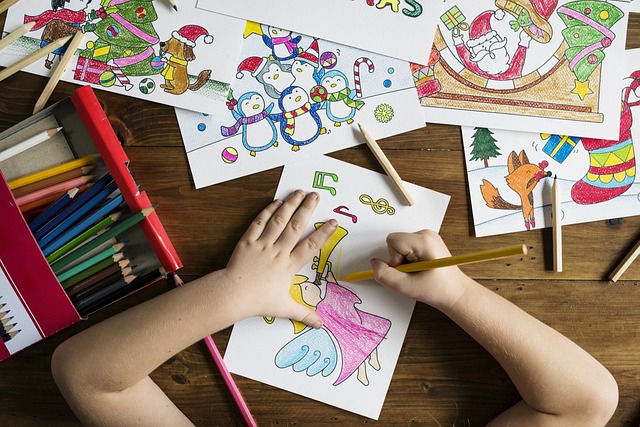Prep Your Space
Before you dip into paint, take a moment to create the right environment. A well-prepared space helps you stay in flow, experiment freely, and avoid frustration later.
Keep It Simple—but Mess-Friendly
- Don’t overcomplicate your setup. A clean, open surface invites action.
- Use drop cloths, butcher paper, or an old bed sheet to protect your workspace.
- Think in layers: the messier your process, the more protection you may need.
Organize Tools for Spontaneity
- Keep essential tools within arm’s reach.
- Use jars, trays, or bins to separate brushes, palette knives, sponges, and other materials.
- Clear clutter that might block your movement or creative thinking.
Choose a Limited Color Palette
A restricted color palette doesn’t limit you—it focuses your composition and gives your work cohesion.
Why Fewer Colors = Stronger Composition
- Fewer hues help highlight contrasts and textures.
- They eliminate choice paralysis and keep you painting, not second-guessing.
- The final piece feels more intentional and unified.
Tips for Mixing and Matching
- Vibrant Look: Pick one dominant hue plus two accent colors.
- Muted Effect: Stick to earth tones or complementary color pairs.
- Keep a color wheel nearby for reference during experimentation.
Test Out Your Tools
Before diving into your main composition, explore how each tool behaves with paint. These mini tests can spark new technique ideas—and prevent surprise mishaps on your final piece.
Experiment with Texture
- Fork: Drag through thick, wet paint for grooved textures.
- Sponge: Dab for soft blends, cloudy textures, or organic transitions.
- Old Credit Card: Scrape across the surface for bold, uneven strokes or to carve into paint layers.
Get to Know Behavior
- Test how paint reacts to pressure, speed, and different surfaces.
- Try mixing media—see how ink or charcoal interact with acrylic.
Layer Techniques
The magic often happens in the layers. But layering takes intention—otherwise, your colors might blend into mud or overwhelm the base composition.
Tips for Strong Layering
- Go from light to dark to preserve luminosity.
- Start thin: Dilute initial coats with water or medium.
- Dry between layers: Wait until each layer sets before adding new elements to avoid smearing or overblending.
Knowing When to Stop
- Step back from your work regularly. Does it feel balanced?
- Look for overworked areas; sometimes less is more.
- Trust your instinct—if something feels done, it probably is.
Introduction
Vlogging didn’t just survive the digital chaos of the past few years—it adapted. While platforms shifted algorithms and trends came and went, creators kept showing up. They doubled down on community, authenticity, and niche content. That resilience paid off. Even in the age of short attention spans and endless content scrolls, the best vloggers found ways to hold the room.
Now, in 2024, the field’s leaning more technical but also more human. Success isn’t about chasing virality—it’s about showing up with clarity and purpose. Algorithms are more demanding, audiences smarter, and the tools sharper. What’s changing this year matters because it separates the casual uploader from the serious creator. The ones who pay attention, adapt, and keep connecting? They’ll win.
You don’t need a high-end art studio to start creating. In fact, most of what you need is probably sitting in your kitchen drawer or junk box. Sponges, forks, credit cards, and paper towels can be surprisingly powerful tools for texture, layering, and blending. They’re cheap, easy to replace, and fun to experiment with.
For paint, stick to household acrylics or whatever half-used tubes you’ve got lying around. You’re not aiming for a gallery piece here—just movement, color, and expression.
Set aside a solid workspace. Even just clearing a patch on the floor or kitchen table works. Cover it with scrap paper or cardboard, throw on some old clothes, and keep a rag nearby. If you want crisp edges or a pro-level finish, masking tape and heavy paper (like canvas sheets or watercolor paper) can go a long way. But again—use what you’ve got. The most important part isn’t the prep. It’s starting.
Micro-Niching for Loyal, High-Intent Audiences
In 2024, creators aren’t just chasing audiences—they’re curating them. Micro-niching is where things are getting serious. This means narrowing your content down to something oddly specific: think ‘minimalist baking for busy dads’ or ‘vintage motorcycle travel for beginners.’ It sounds limiting, but it’s anything but.
Niche doesn’t mean small. It means focused. And focus breeds loyalty. A creator talking about one sharp topic builds trust with viewers who see themselves reflected in the content. This trust leads to more meaningful interactions, higher retention, and a community that shows up consistently. When your audience feels seen, they stick around—and they spend.
That loyalty pays off. Monetization gets easier when your subscribers actually care. From brand deals tailored to tight demographics to community memberships and product lines, niche audiences convert at a higher rate than general ones ever do. So while the masses scroll past, micro-niche creators are quietly building empires, one tight-knit fanbase at a time.
Abstract Art: From Stress to Expression
Creativity as a Stress Outlet
Abstract art isn’t about perfection—it’s about presence. When life becomes overwhelming, channeling stress into paint, line, and form can be surprisingly soothing. Abstract expression offers freedom where words fall short.
- No rules, just release
- Let motion and messiness tell the story
- A canvas becomes a safe space to express what you can’t explain
Don’t Overthink It
Some of the most compelling abstract pieces come from simply starting, not strategizing. Overthinking can stifle creativity, especially when the goal is to unwind rather than impress.
Try this:
- Set a timer for 10 minutes and don’t stop moving your brush or tool
- Work with your non-dominant hand to interrupt control
- Focus on feeling, not form
Start with What You Have
Getting started doesn’t require fancy tools or a well-stocked studio. Abstract art invites you to explore with what’s nearby.
Grab:
- Paper scraps, old magazines, or cardboard
- Pens, pastels, or paint—whatever’s available
- Curiosity as your guide
Give Yourself Permission to Play
The only requirement is a willingness to explore. Let your hands move, let go of outcomes, and watch what unfolds.
Abstract art is where emotion becomes motion—and every mark matters.
-
Frame it, gift it, or post it online
Once you’ve got a finished piece, don’t just let it sit in your camera roll or sketchbook. Frame it and hang it up. Give it to someone—no holiday required. Or post it online and watch how others respond. The point is to let your work breathe beyond your workspace. -
Use your work as the base for a collage or print piece
Don’t be afraid to cut it up. Scan it. Layer it. Take pieces of what you’ve made and remix them into something new. Whether you’re into zine layouts, digital collages, or greeting cards, your original work can spark more than one creative take.
Want to explore more creative outlets? Check out Fun and Easy Printmaking Projects for Beginners

 Trevana Kelthorne, the visionary behind FLP Emblemable, built the platform on a passion for creativity, artistic exploration, and global expression. With years spent studying diverse art movements and supporting emerging creators, she founded FLP Emblemable to give artists a space where ideas, techniques, and inspiration can flow freely. Trevana’s mission is to connect communities through art, encourage experimentation, and spotlight the voices shaping tomorrow’s creative world.
Trevana Kelthorne, the visionary behind FLP Emblemable, built the platform on a passion for creativity, artistic exploration, and global expression. With years spent studying diverse art movements and supporting emerging creators, she founded FLP Emblemable to give artists a space where ideas, techniques, and inspiration can flow freely. Trevana’s mission is to connect communities through art, encourage experimentation, and spotlight the voices shaping tomorrow’s creative world.